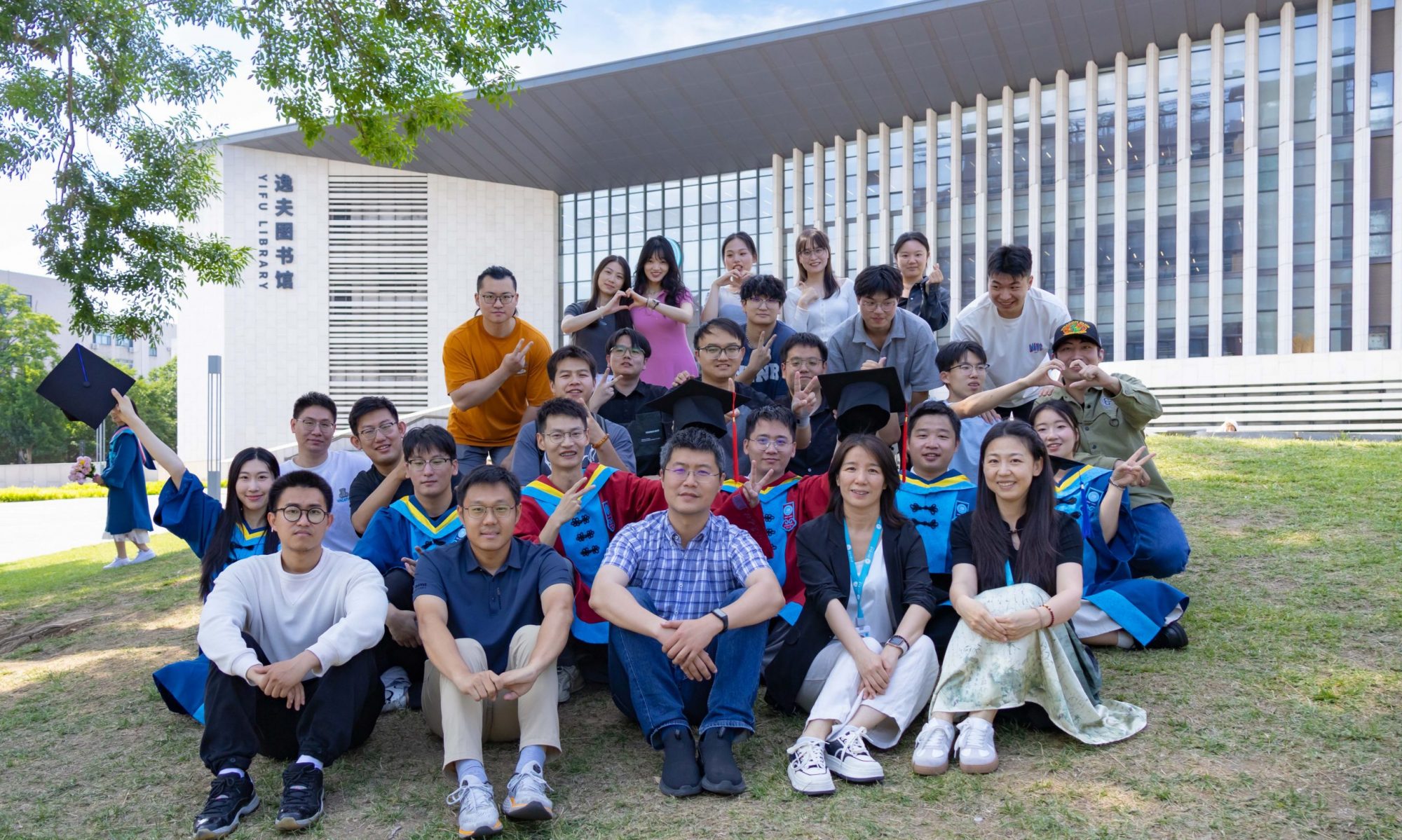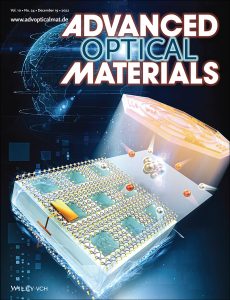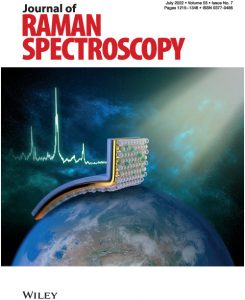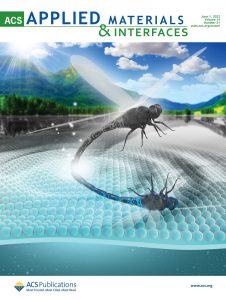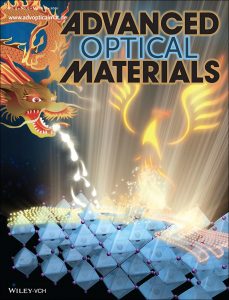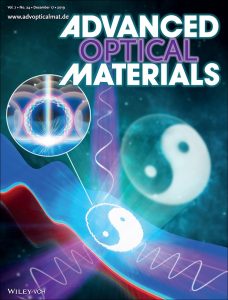Institute of NanoPhotoniX (INPX)
微纳光学研究所(北京工业大学,物理与光电工程学院,闫胤洲)

微信扫一扫 关注实验室公众号
News
(06/06/2025) A nanohole-in-microsphere array (NiMA) for digital SERS (dSERS) analysis is achieved by high-throughput fs-laser parallel fabrication. The NiMA possesses high precision in liquid sampling (10−18 L) and ultralow limit of detection for single-molecule-level counting following corrected Poisson’s statistics. The developed NiMA-dSERS successfully diagnoses rheumatoid arthritis patients by label-free sera with the accuracy of 88.0 %, sensitivity of 92.9 % and specificity of 81.8 %, manifesting the feasibility of dSERS protocol for clinical diagnosis of early-stage autoimmune diseases. Link
(09/05/2025) An elastomeric fluorophlogopite SERS substrate composed of an Ag-coated hierarchical micropillar-nanostructure array is fabricated by fs-laser cross-scribing. The wettability of the substrate is reversibly tuned by mechanical strain from a free superhydrophobic surface in Cassie state to a compressive hydrophilic one in Wenzel state, facilitating to ultrasensitive Raman detection down to 0.1 fM with anti-pollution for long-term storage. Link
(06/05/2025) Cover of ACS Nano. This cover image refers to the article “Ultrafast Laser-Induced 1T′/2H-MoTe2 Nanopattern with Au-Nanoclusters for Raman Monitoring of Cellular Drug Metabolism” by Yao Yao, Yue Zhao, Xinlong Yan, Yinzhou Yan and co-workers.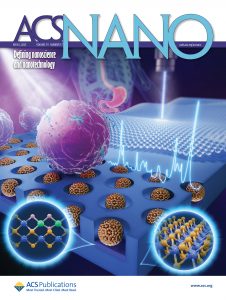
(18/04/2025) An ultrafast laser parallel fabrication protocol for high-throughput nanopatterning of 1T’-phase on 2H-MoTe2 for in-situ reduction of Au nanoclusters (AuNCs) is developed. The formed AuNCs@1T’/2H-MoTe2 offers a robust bio-SERSomes platform to monitor the metabolic behaviors of living gastric adenocarcinoma cells administrated by therapeutic drugs. Link
(19/03/2025) A angle-twisted interference lithography for narrow-gap Au nanofilm (AuNF) Moire-gratings with tunable absorptance wavelengths is proposed. The synergetic effect of Moire-grating SPR and narrow-gap LSPR enhances the near-field light regardless of the excitation polarization state. It provides opportunities to polarization-insensitive SERS with tunable excitation wavelengths for practical applications. Link
(08/02/2025) A compact microsphere self-interference lithography via a single laser beam incident into a self-assembled dual-layered microsphere array is developed, achieving polarization-dependent high-throughput parallel fabrication of periodic units with nanopatterns. Link
(25/01/2025) An invited review on Recent Advances in Optical Microcavity Enhanced Fluorescence and Raman Spectroscopy (in Chinese) has been published in Chinese Journal of Luminescence. Link
(10/01/2025) A review on Microsphere Super-Resolution Optical Imaging: Principles, Techniques, and Applications (in Chinese) has been published in Journal of Beijing University of Technology. Link
(06/01/2025) Congratulations to Mr. Zelin Chen, for the Outstanding Paper Award of Chinese Journal of Lasers in 2024. Link
(02/07/2024) Congratulations to Dr. Yanlin Mi and Ms. Bingbing Chen, awarded Outstanding PhD dissertation of BJUT (Dr. Yanlin Mi) and Outstanding MPhil dissertation of BJUT (Ms. Bingbing Chen).
Read More(30/05/2024) A microsphere-coupled SERS with the convolutional neural network algorithm is developed to diagnose neuropsychiatric systemic lupus erythematosus (NPSLE) by examining the Raman spectra of serums. Eight Raman shifts are identified, for the first time, as the characteristic spectral markers. The present work paves a new way achieving SERS-based clinical label-free serum diagnosis of rheumatic diseases. Link
(21/04/2024) Congratulations to Ms. Yongman Pan, for the Best Poster Award of the 10th Chinese Academic Conference of Zinc Oxide and Related Materials.
(10/04/2024) The well-ordered dual-Au-nanoholes with the tip gap of ≈90 nm on a microsphere-lens-array (MLA/2-AuNHs) are fabricated by incident-angle-dependent photonic nanojet ablation. The MLA/2-AuNHs structure facilitates multiple optical regulation promoting Raman scattering as a flexible SERS substrate. The polarization-dependent response highlights the Raman signals by differential spectra eliminating background noise, enabling ultrasensitive detection down to 10−12 M. Link
(30/03/2024) Congratulations to Ms. Yanlin Mi, for the Best Poster Award of NCRBA 2024.
(27/03/2024) A cascade microsphere-cavity structure, composed of two size-mismatched microspheres supporting optical whispering-gallery modes with significantly different free-space ranges, is developed to achieve strong-coupling-enhanced Raman spectroscopy (SCERS). It provides an extra enhancement channel with an enhancement factor up to 2.6 × 1010 for the limit of detection down to 10−12 M. Link
(19/02/2024) Rapid photochemical reduction of hierarchical Ag micro-nanostructure is achieved through the multiple optical field modulation of dielectric microspheres, which demonstrates a high Raman enhancement factor of up to 9.50×109 and a detection limit of 10-14 mol/L for trace detection. This study provides a new strategy for creating ultra-sensitive dielectric/metal hybrid SERS substrates with low cost and high performance for practical applications. Link
(23/11/2023) A plasmon-free SERS probe by a tapered optical fiber (TOF) coated with monolayer-MoS2 is demonstrated, where the TOF-supported whispering-gallery modes (WGMs) simultaneously regulate excitonic, molecular and charge-transfer resonance as well as fluorescence resonance energy transfer processes for Raman enhancement with 1.8 × 109-fold for 10-14 M. The SERS probe demonstrates outstanding feasibility and stability facilitating to trace detection in microdroplets for practical applications. Link
(17/11/2023) Congratulations to Ms. Yanlin Mi, for the Best Poster Award of International Postgraduate Photonics Forum (IPPF) in the Conference on Micro/nano Optical Technology and Application.
(02/11/2023) A temperature sensing structure using microsphere-cavity-array capped PeQDs (MCA/PeQDs) film is proposed, where the temperature sensing is realized by the temperature-dependent photoluminescence intensity ratio of the MCA/PeQDs structure to the bare one, for the first time. Link
(25/09/2023) Congratulations to Mr. Mengyuan Wang, for the Young Best Research Paper Award of the 22nd Chinese National Conference on Light Scattering.
(03/07/2023) Congratulations to Ms. Xiaohua Zhang and Ms. Linna Hu, awarded Beijing Outstanding Postgraduate (Ms. Xiaohua Zhang) and Outstanding MPhil dissertation of BJUT (Ms. Linna Hu).
(22/02/2023) A microsphere-cavity-array (MCA) structure is developed to improve the degree of valley polarization (DoP) and PLQY of ML-WSe2. The contribution of boosted localized density of charged excitons by nanofocusing and enhanced population decay by WGM-induced Purcell effect in MCA/ML-WSe2 to DoP is experimentally confirmed, for the first time. Link
(20/12/2022) Front cover of Advanced Optical Materials. A novel strategy to generate and manipulate robust bound states in the continuum (BICs) in a few-layer tungsten disulfide (WS2) integrated photonic crystal slab is theoretically demonstrated. The surrounding eight isolated BICs in momentum space move towards the center with electrically tuning the carrier density in few-layer WS2. BICs with opposite topological charge annihilate in the merging process to achieve a high quality factor in a large area at the center. This cover image refers to the article “Electrically Tunable and Robust Bound States in the Continuum Enabled by 2D Transition Metal Dichalcogenide” by Chen Zhao, Yinzhou Yan, Yongzhe Zhang, Cheng-Wei Qiu and co-workers.
(08/12/2022) Congratulations to Ms. Yao Yao for the Best Poster Award of Chinese Physical Society (CPS) 2022 Fall Meeting.
(20/10/2022) The merged and isolated bound states in the continuum (BICs) are manipulated in momentum space by tuning carrier density in 2D material or distorting magnitude of the hole in each unit of photonic crystal. The inversion of topological charge at Γ point is therefore realized. Link
(16/07/2022) Cover of Journal of Raman Spectroscopy. We developed a novel flexible microsphere-coupled SERS (McSERS) substrate composed of a microsphere cavity array and random AuNPs on a flexible PDMS film. The dielectric/metallic multiscale structure contributes to powerful strength in optical manipulation and energy transfer for giant Raman enhancement up to 10^7-fold for the limit of detection down to 0.1 nM. It provides a facile strategy to fabricate high-performance Raman enhancer with good flexibility for optical trace-detection in practical applications. This cover image refers to the article “Flexible microsphere-coupled surface-enhanced Raman spectroscopy (McSERS) by dielectric microsphere cavity array with random plasmonic nanoparticles” by Yinzhou Yan and co-works.
(12/07/2022) Welcome Dr. Chen Zhao and Dr. Zhiyang Xu joining us.
(01/07/2022) Congratulations to Dr. Cheng Xing, Ms. Jing He, and Mr. Tao Wang, awarded Outstanding PhD dissertation of BJUT (Dr. Cheng Xing), Outstanding MPhil disstertation of BJUT (Ms. Jing He and Mr. Tao Wang), and Beijing Outstanding Postgraduate (Ms. Jing He).
(01/06/2022) Cover of ACS Applied Materials & Interfaces. A microsphere photonic superlens (MPS) covered onto upconversion-nanoparticle-embedded film paves a new way achieving robust optical regulation for highly efficient upconversion emission. The high flexibility of MPS facilitates multiphoton upconversion materials towards wearable applications for highly sensitive visible imaging and anticounterfeiting from invisible near-infrared band. The cover image refers to the article “Microsphere Photonic Superlens for a Highly Emissive Flexible Upconversion-Nanoparticle-Embedded Film” by Yinzhou Yan and co-workers.
(18/05/2022) Giant upconverion luminescence enhancement, from a flexible UCNP-embedded film, up to 104-fold under ultralow NIR excitation has been achieved by coupling a microsphere photonic superlens (MPS) array. Link
(08/04/2022) A facile flexible microsphere-coupled SERS (McSERS) test strip, composed of a dielectric microsphere cavity array and random gold nanoparticles capping on a polydimethylsiloxane film, has been developed, for on-site Raman trace-detection. Link
(04/01/2022) A cascaded microsphere-coupled SERS has been developed to increase the molecular concentration, boost the intensity of localized excitation light, and direct the far-field emission for ultrasensitive Raman detection. Link
(07/09/2021) Dr. Yinzhou Yan has been promoted to Full Professor since July 2021.
(21/08/2021) The high-performance flexible transparent electrodes have been fabricated by a facile method, i.e. nanosecond pulsed-laser irradiation induced nano-welding of silver nanowires on PMMA/PDMS organic films. Link.
(12/08/2021) A novel ZnO microtubular homojunction UV photodiode is fabricated by optical vapor supersaturated precipitation and sputtering methods. The acceptor-rich ZnO microtube possesses a great UV-VIS rejection ratio and a high external quatum yield. The formed homojunction UV photodiode with n-ZnO:Sn achieves an ultrafast photoresponse and a high sensitivity, especially suitable for weak-signal UV detection. This is the first high-performance optoelectronic device of the acceptor-rich ZnO microtube first found in 2016, promoting their potentials in future. Link
(24/06/2021) A thermal-assisted UV-photon irradiation strategy is proposed to manipulate the defects in ZnO microwires, by which the PL and EL emission can be boosted for fabrication of high-efficient wide-bandgap semiconductor optoelectronic devices. Link
(25/05/2021) The In2O3(ZnO)m (IZO) superlattice microplates with hexagonal morphologies are fabricated by substrate-free optical vapor supersaturated precipitation. The heavy doping of In in the IZO superlattice with a zig-zag modulater pattern is realized, for the first time. Link
(19/04/2021) Congratulations to Ms. Lixue Yang, distinguished with the honor of the 17th Wang Daheng Award in Optics, 王大珩光学奖高校学生奖 (for top 30 outstanding postgraduates studying optics in China).
(19/03/2021) Cover of Advanced Optical Materials. A novel spontaneous radiation amplification strategy for trihalide perovskite films is demonstrated by Yinzhou Yan and co‐workers in the article “Spontaneous Radiation Amplification in a Microsphere‐Coupled CsPbBr3 Perovskite Vertical Structure“. A patterned microsphere monolayer is capped on the perovskite microcrystal film achieving selective luminescence enhancement with highly‐directional emission. Such a vertical structure will have great application prospects in future light‐emitting and optoelectronic devices. Impact by Chinese dragon and phoenix on the cover points to promising prospects of the research on microsphere‐enhanced luminescence for novel perovskite materials.
(14/02/2021) A microsphere-coupled inorganic halide perovskite vertical structure is proposed for amplification of spontaneous radiation. The capability of whispering-gallery resonance for boosting of spontaneous radiation and suppression of exciton-phonon interactions is demonstrated. Furthermore, a novel anticounterfeiting strategy is developed via a patterned microsphere cavity array. This work is published in Advanced Optical Materials. Link
(04/02/2021) Cover of Journal of Materials Chemistry C. Current-induced thermal tunneling electroluminescence with tunable colors from a biased highly-compensated ZnO:Ga microrod at high temperature will have great potentials for novel light-emitting microdevices with efficient radiation. The cover image refers to the article “Current-induced thermal tunneling electroluminescence via multiple donor–acceptor-pair recombination” by Yinzhou Yan and co-workers. 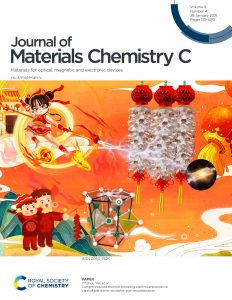
(22/01/2021) Highly-efficient intrinsic electroluminescence (IEL) from a biased highly-compensated ZnO:Ga microrod with a metal–semiconductor–metal (MSM) structure is realized. The Ga doping is found to be beneficial to lower the temperature threshold down to ∼650 K, facilitating the stability and durability of MSM-IEL devices. This work is published in Journal of Materials Chemistry C. Link
(24/08/2020) Congratulations to Mr. Wu Xia, awarded Excellent MPhil Dissertation of BJUT.
(30/07/2020) Congratulations to Ms. Lixue Yang, awarded PhD Innovative scholarship of BJUT (for top 19 outstanding PhD students).
(10/06/2020) Current-induced thermal tunneling electroluminescence is achieved in a homogeneous highly compensated ZnO microrod. The tunneling mechanism of Joule-heating-facilitated excitation is revealed. The color-tunable EL emission is also demonstrated by regulation of donor concentration. This work is published in iScience (Cell Press). Link
(17/12/2019) Cover Image of Advanced Optical Materials. A Tai Chi patterned microsphere‐cavity array on a flexible quantum dot film to enhance and direct white‐light emission is demonstrated here. Two aspects of a material, i.e. rigidity and flexibility, are implied by the symbol. The microsphere cavity is rigid with stable optical properties, while the microsphere array is flexible due to the weak connection between the microspheres. The cover image, referring to article “Over 1000‐Fold Enhancement of the Unidirectional Photoluminescence from a Microsphere‐Cavity‐Array‐Capped QD/PDMS Composite Film for Flexible Lighting and Displays” by Yinzhou Yan and co‐workers, combines Chinese traditional culture with modern science to motivate new ideas in flexible nanophotonics.
(16/12/2019) The tubular acceptor-rich ZnO (A-ZnO) hierarchical heterostructure is fabricated for highly efficient photodegradation of organic dyes. The A-ZnO/n-ZnS forms a type II heterojunction to boost the charge separation, achieving the photodegradation rate up tp 0.105 min-1. It paves a new way to the tubular A-ZnO-based hierarchical heterojunction for high-performance optoelectronic devices. This work is published in Applied Surface Science. Link
(27/11/2019) Congratulations to Mr. Cheng Xing, awarded National Scholarship of China.
(23/10/2019) A dielectric microsphere cavity array for over 1000‐fold enhancement of the photoluminescence in quantum dot composite films with a highly unidirectional emission angle is demonstrated. The optical whispering‐gallery resonance and directional antenna contribute to the major enhancement. This cavity array also allows for enhancement of the white‐light emission in an hybrid composite film, with promising applications in flexible lighting/display devices. This work is published in Advanced Optical Materials. Link
(06/09/2019) Congratulations to Ms. Lixue Yang for her Best Poster Award of the 7th Asian Symposium on Advanced Materials (for top 2 conference posters).
(16/08/2019) Congratulations to Ms. Lixue Yang for her Best Poster Award of the 15th Luminescence Conference of China (for top 5 conference posters).
(28/06/2019) Congratulations to Dr. Qiang Wang, Ms. Zihan Huang and Ms. Yujie Zhang, for their Outstanding Postgraduate and Excellent Dissertation Awards of BJUT.
(24/06/2019) Congratulations to Mr. Cheng Xing, the winner of PhD Innovative scholarship of BJUT (for top 24 outstanding PhD students).
(15/05/2019) A novel hybrid microsphere cavity/dual metallic nanoparticles sandwich structure has been developed for UV luminescence enhancement in a planar wide bandgap semiconductor film. It provides a simple and easily-prepared approach incorporating optical WGMs and LSPRs to effectively manipulate luminescence emission for potential optoelectronic applications. This work is published in Optics Express. Link
(16/04/2019) Congratulations to Mr. Qiang Wang, distinguished with the honor of the 15th Wang Daheng Award in Optics, 王大珩光学奖高校学生奖 (for top 30 outstanding postgraduates studying optics in China).
(14/04/2019) Congratulations to Ms. Zihan Huang. She won the Best Poster Award of the 9th Chinese Academic Conference of Zinc Oxide (for top 5 conference posters).
(15/03/2019) A variety of hierarchic nanostructures on the undoped acceptor-rich ZnO (A-ZnO) single-crystal microtube have been fabricated by a simple approach – KrF excimer laser irradiation. The boosted optoelectronic and photocatalytic properties of the nanostructure-decorated microtubes are beneficial for design of on-chip wide-band-gap semiconductor devices with high performance. This work is published in Journal of Alloys & Compounds. Link
(06/01/2019) The effect of self-absorption on excitonic luminescence in ultrathin-walled wide-band-gap semiconductor microtube cavity has been revealed. It opens up new opportunities to enhance photons collection and interaction with excitons in the 3rd-generation semiconductors for on-chip wavelength-tunable UV-luminescence devices. This work is published in Journal of Luminescence. Link
(13/09/2018) Congratulations to Ms. Yujie Zhang. She won the Best Poster Award of Chinese Physical Society (CPS) 2018 Fall Meeting (for top 10% of conference posters)
(05/07/2018) Congratulations to Mr. Shuopeng Hu, Outstanding Postgraduate of Beijing University of Technology. His MPhil dissertation has been awarded the Excellent MPhil dissertation of BJUT.
(04/12/2017) Congratulations to Mr. Cheng Xing. He won the Best Poster Award in the 19th Chinese National Conference on light Scattering (for top 8% conference posters).
(20/11/2017) Congratulations to Mr. Qiang Wang, awarded National Scholarship of China.
(31/10/2017) Congratulations to Ms. Lixue Yang. She won the Materials Chemistry Frontiers poster award at the 8th Chinese Academic Conference of Zinc Oxide (for top 3 conference posters) issued by the Royal Society of Chemistry.
(30/10/2017) Dr. Yinzhou Yan was awarded Outstanding Reviewer for Optics & Laser Technology, Elsevier.
(27/10/2017) Optical microcavities: Hexagonal cavities boost ultraviolet light. Microscale semiconductor tubes that emit ultraviolet laser/light have been developed. Lasers employ an optical cavity that boosts light like the body of a guitar amplifies sound. The miniaturization of lasers requires smaller cavities, which can be difficult to fabricate with high precision and reproducibility. We have created microscale semiconductor tubes and have demonstrated their ability to enhance optical emission. We used a method they developed — optical vapor supersaturated precipitation — to make hexagonal zinc oxide tubes that were 50 micrometers in diameter and had walls that were just 750 nanometers thick. We showed that these structures can trap and enhance light in multiple fields, demonstrating their flexibility for optoelectronic applications. The exciting result is published in NPG Asia Materials (Nature Publishing Group). Link
(17/10/2017) Congratulations to Mr. Shuopeng Hu. He won the Best Poster Awards in The 7th Asian Conference on Crystal Growth and Crystal Technology (for top 8% of conference posters)
(19/09/2017) A flexible microsphere-embedded films as a microsphere-enhanced Raman spectroscopy (MERS) sensing platform has been developed. The flexible film can be used for improved Raman detection on 1D-3D surfaces and be coupled with SERS for ultrasensitive trace chemo-sensing. The exciting result is published in ACS Applied Materials & Interfaces. Link
(20/06/2017) Dr. Yinzhou Yan has been enrolled in Beijing Youth Talent Development Program.
(06/06/2017) Congratulations to Mr. Qiang Wang. He has been sponsored by CSC for one-year overseas study at Johns-Hopkins University (USA).
(07/03/2017) The mechanisms of microsphere-enhanced photoluminescence have been revealed by a sandwich structure. It would provide a novel platform to manipulate light enhancing photon-matter interaction and achieve energy-saving luminescence in future. This work is published in Optics Express. Link
(21/11/2016) Dr. Yinzhou Yan has been enrolled in Beijing Nova Program for academic talents.
(03/09/2016) Congratulations to Mr. Qiang Wang. He awarded the Best Poster Prize of Chinese Physical Society (CPS) 2016 Fall Meeting (for top 10% of conference posters)
(06/06/2016) A novel type of ZnO – undoped acceptor-rich ZnO microtube has been successfully fabricated by optical vapour supersaturated precipitation. The exciting result is reported by Scientific Reports. Link
(25/09/2015) Our latest work on microsphere-based Raman scattering enhancement has been published in Optics Express. Link
(26/06/2015) Congratulations to Mr. Cheng Xing, whose undergraduate dissertation has been awarded the Excellent Bachelor dissertation of Beijing University of Technology (for top 3% of undergraduate dissertations in the university).![]()
